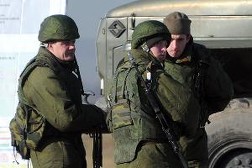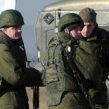
Another Clash Reported Between Security Forces and Rebels in Chechnya
Publication: Eurasia Daily Monitor Volume: 11 Issue: 209
By:

As he has done for years, Chechen leader Ramzan Kadyrov was the first to announce the latest government operation against rebel militants in Chechnya. Kadyrov stated on his personal Instagram webpage that government forces had killed a group of four bandits in the republic’s Sunzha district, on the administrative border with Ingushetia. According to Kadyrov, the authorities had been conducting a manhunt for some time. Government sources said they had received information that the militants had been ordered by their leader, Beslan Makhauri (Emir Muhammad), to carry out bomb attacks (instagram.com, November 17). The Chechen Republic’s head specified that government forces had started the special operation a week earlier, after the body of a hunter was found. Russia’s Interfax news agency reported on the government forces’ losses in the operation. “Last night on the outskirts of Sernovodskaya, four members of the bandit underground were surrounded. They used arms to resist the police. In the clash, the bandits were eliminated; two police officers were injured” (Interfax, November 17). The Interfax report shows that law enforcement did not simply happen to be located in the area, but were searching for people accused of killing the hunter.
In a sweep of the area after the active phase of the special operation, which took place on November 17, police discovered what they said was the suspected militants’ hideout. They also provided names of the slain individuals. According to local sources, the rebels were found in the morning and, in response to the government forces’ request to surrender, they started firing chaotically with machine guns and threw a grenade. The militants were killed by police return fire, according to officials (Kavkazsky Uzel, November 18).
The police identified the slain suspects as 40-year-old resident of Nadterechny district Ruslan Akhmatov, 31-year-old resident of Sunzha district Ramzan Esnukaev, 21-year-old resident of Urus-Martan district Imran Khanamagomadov, and 21-year-old resident of Grozny Said Shishbulatov. All four were on the federal wanted list for being members of “illegal bandit groups,” the media reported, referring to a source in the Main Directorate of Chechnya’s Ministry of Interior (Vestnik Kavkaza, November 18). Meanwhile, the insurgents asserted that the police concealed its true losses in the clash (kavkazcenter.com, November 17). The government forces used military helicopters during the operation, according to the rebels.
The area around the administrative border between Chechnya and Ingushetia is believed to have been under the control of Beslan Makhauri’s group, which is primarily made up of residents of Chechnya’s Sunzha and Achkhoi-Martan districts and Ingushetia’s Sunzha district (Kavkazsky Uzel, November 18).
Beslan Makhauri, a.k.a. Emir Muhammad, is the leader of the Sunzha sector of the Velayat Nokhchiycho (as the Caucasus Emirate calls Chechnya). The last time the authorities reported his death was after the terrorist attack on a police station in the village of Sernovodsk in Chechnya’s Sunzha district in October 2013 (06region.ru, October 29, 2013). However, despite multiple reports about his death, Makhauri posed for a video recording in February 2014 (YouTube, February 8). Along with Emir Khamzat (Aslan Batyukaev), the leader of the Chechen militants, and Emir Yakub (Makhran Saidov), who heads the Tsentoroi sector in Chechnya, Makhauri is the worst enemy of Ramzan Kadyrov in Chechnya’s armed underground resistance.
Makhauri is wanted on Article 317 of the Russian Criminal Code, which covers attempts on the life of a law enforcement agent and envisages by way of punishment, at minimum, twelve to twenty years in prison, with restriction of liberty for up to two years, or life imprisonment or the death penalty. He is also accused of violating Article 222, coving the illegal purchase, transfer, sale, storage, transportation or carrying of weapons, ammunition, explosives and explosive devices, and envisages by way of punishment imprisonment from five to eight years (consultant.ru, accessed November 21).
Even though Ramzan Kadyrov has, for the past ten years, been trying to convince everybody, including himself, that there are no militants in Chechnya, the news about the latest clashes between government forces and militants was widely reported by the media. Indeed, other incidents involving militants in the republic are notable for the same reason. In particular, the man who carried out the suicide bombing in Grozny on October 5, the Chechen capital’s City Day (rbc.ru, October 5), was not simply a loner, but had ties to other people (lenta.ru, October 18). And later in the month, on October 25, the authorities unexpectedly announced the killing of a militant in the area of the villages of Kadi Yurt and Engel Yurt in Chechnya’s Gudermes district (TASS, October 25). Kadyrov stated that there were two militants, meaning one of them managed to escape.
Against the backdrop of these events, it is probably not a coincidence that the government revealed information about the modernization of T-72B3 tanks for the Southern Military District motorized infantry unit stationed in the southwestern part of the Chechen city of Shali (stav.aif.ru, November 18). The emphasis of the news report was on “modernization,” otherwise it is hard to perceive the T-72 as a new tank, since it was designed in 1967 and adopted by the Soviet military in 1973. The Russian military command also decided to station Chechen conscripts—once again being called up to serve in the Russian Armed Forces (see EDM, September 25)—within the limits of the Southern Military District, which is closer to home, and not send them to Vladivostok along with other North Caucasians (gazeta.ru, November 17). The Russian government also continues to dispatch special forces from all over Russia to serve in Chechnya; no end to this practice is in sight.
Thus, the fall of 2014 became significantly more eventful than the preceding year in Chechnya. Earlier, the main news regarding militant activities in the republic concerned the leader of the Caucasus Emirate, Doku Umarov. Now, news is once more becoming more prevalent regarding clashes between government forces and rebels from various parts of Chechnya. Whether this is a sign that the rebel forces are reorganizing, or this has been a series of several isolated events, will be clarified in the next few months.




